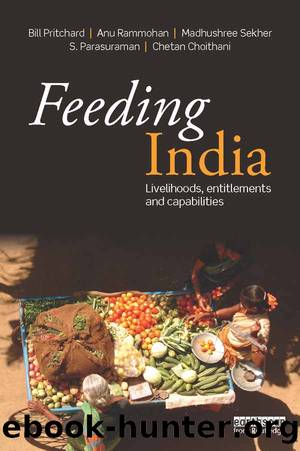Feeding India by unknow

Author:unknow
Language: eng
Format: epub
Tags: Social Science, Developing & Emerging Countries
ISBN: 9781136304798
Google: xLWoAgAAQBAJ
Barnesnoble:
Publisher: Routledge
Published: 2013-08-15T00:00:00+00:00
Source: Office of the Economic Advisor (2013)
FIGURE 5.3 Wholesale food price inflation, 2008â12, cereals and pulses
Source: Office of the Economic Advisor (2013)
MSP, pricing methodologies have favoured wheat and rice cultivation. Only in the past few years have Indian policymakers specifically raised the MSP for pulses at a faster rate than for wheat and rice, in an effort to boost production (Dev, 2012). In the future, it may be expected that the effects of these policies will kick in, with one researcher forecasting âan increase in consumption of pulses as the availability increasesâ (Dev, 2012: 14). With respect to the PDS, in most Indian States, pulses are not included within the PDS, meaning that poor households tend to be wholly reliant on the private-sector operations of the market, if they are to obtain pulses. The increase in the price of pulses over the past few years might be expected to have induced a substantial effect on the poor population's inclusion of these items in their diets. It goes without saying that pulses play a crucially important nutritional role for poor people, as they are a major source of iron and protein within diets which, either by religious taboo or poverty, often have minimal or no meat or eggs.
Similarly, the growth in the wholesale prices of raw and unprocessed fruits and vegetables was faster than the average inflation rate for all consumption sectors, and this was more notable for vegetables than fruits. Again, as a general rule, vegetables represent a core component of diets of the poor, while fruits, although important, to a certain degree encompass a discretionary element. According to calculations by Carrasco and Mukhopadhyay (2012: 8), fruits and vegetables were the largest single contributor to food price inflation in India during the period from 2007 to 2011. These trends are captured in Figure 5.4. In this diagram, seasonal fluctuations in prices are seen to impose a strong effect, although year-to-year patterns have
FIGURE 5.4 Wholesale food price inflation, 2008â12, fruits and vegetables
Download
This site does not store any files on its server. We only index and link to content provided by other sites. Please contact the content providers to delete copyright contents if any and email us, we'll remove relevant links or contents immediately.
| Chakras | Gandhi |
| History | Rituals & Practice |
| Sacred Writings | Sutras |
| Theology |
Fingersmith by Sarah Waters(2406)
Kundalini by Gopi Krishna(2094)
Wheels of Life by Anodea Judith(1922)
The Bhagavad Gita by Bibek Debroy(1867)
Indian Mythology by Devdutt Pattanaik(1856)
The Yoga of Jesus: Understanding the Hidden Teachings of the Gospels by Paramahansa Yogananda(1752)
Autobiography of a Yogi (Complete Edition) by Yogananda Paramahansa(1739)
The Man from the Egg by Sudha Murty(1683)
Chakra Mantra Magick by Kadmon Baal(1589)
The Book of Secrets: 112 Meditations to Discover the Mystery Within by Osho(1588)
The Sparsholt Affair by Alan Hollinghurst(1509)
Avatar of Night by Tal Brooke(1451)
Sparks of Divinity by B. K. S. Iyengar(1450)
Karma-Yoga and Bhakti-Yoga by Swami Vivekananda(1437)
Gandhi by Ramachandra Guha(1435)
The Bhagavad Gita (Classics of Indian Spirituality) by Eknath Easwaran(1418)
The Spiritual Teaching of Ramana Maharshi by Ramana Maharshi(1373)
Hinduism: A Very Short Introduction (Very Short Introductions) by Knott Kim(1314)
Skanda Purana (Great Epics of India: Puranas Book 13) by Bibek Debroy & Dipavali Debroy(1309)
